 W
WAntergos is a discontinued Linux distribution based on Arch Linux. It includes the GNOME desktop environment by default but it could also employ the Cinnamon, MATE, KDE Plasma 5, Deepin, and Xfce desktops. It was first released on July 2012 as Cinnarch and by June 2013 it was ranked among the top 40 most popular distributions viewed at DistroWatch. The Galician word Antergos was chosen "to link the past with the present".
 W
WAsturix OS is a discontinued Linux distribution based on Ubuntu. It is no longer maintained.
 W
WBackTrack was a Linux distribution that focused on security, based on the Knoppix Linux distribution aimed at digital forensics and penetration testing use. In March 2013, the Offensive Security team rebuilt BackTrack around the Debian distribution and released it under the name Kali Linux.
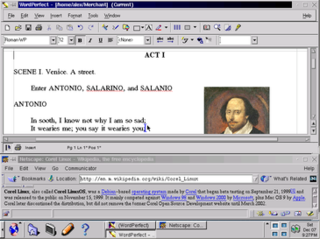 W
WCorel Linux, also called Corel LinuxOS, was a Debian-based operating system made by Corel that began beta testing on September 21, 1999 and was released to the public on November 15, 1999. It mainly competed against Windows 98 and Windows 2000 by Microsoft, plus Mac OS 9 by Apple. Corel later discontinued the distribution, but did not remove the former Corel Open Source Development website until March 2002.
 W
WCrunchBang Linux was a Linux distribution derived from Debian by Philip Newborough.
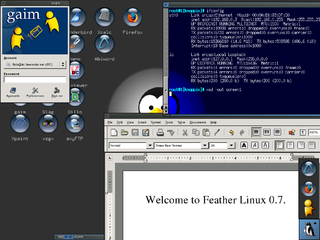 W
WFeather Linux, created by Robert Sullivan, was a Knoppix-based operating system which fits in under 128 MB. It boots from either a CD or a USB flash drive, into a Fluxbox desktop environment. It has a wide range of desktop and rescue software, and can load entirely into RAM or be installed to a hard drive. Feather Linux contains GTK+ applications, such as AbiWord and Pidgin. Feather Linux has tried to include software that people would frequently be using on their desktop.
 W
WForesight Linux was a Linux distribution comprising free and proprietary software with the goal of showcasing the latest in Linux desktop technologies. Foresight is developed by the Foresight community and is based on rPath, it also follows a rolling release cycle, instead of a time-based release schedule.
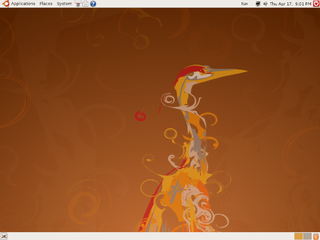 W
WGobuntu was a short-lived official derivative of the Ubuntu operating system that was conceived to provide a distribution consisting entirely of free software. It was first released in October 2007.
 W
WgOS or "good OS" was an Ubuntu-based Linux distribution created by Good OS LLC, a Los Angeles-based corporation. Its CIO David Liu described that after meeting Enlightenment and open source people, he realized that his dream to bring Web 2.0 applications into mainstream use could be achieved by creating a Linux distribution that made it easy for users to access Google and Web 2.0 applications. David Liu went on to create the Chinese Twitter clone called Wozai (我在), leaving gOS officially defunct.
 W
WJurix was an early Linux distribution created by Florian La Roche, a former employee of the legal department at Saarland University. The distribution was maintained between 1993 and 1999 and hosted on the now-defunct "jurix.jura.uni-sb.de" and "susix.jura.uni-sb.de" domains.
 W
WKongoni is a Linux distribution that used the free version of the Linux kernel as distributed by the Linux-libre project. Development of the Kongoni project is currently dormant.
 W
WKurumin Linux was a Live CD operating system based on Debian. Its main features are the advanced hardware auto-detection and a Portuguese user interface, and its main goal is ease of use. As of release 7.0, the size of the disk image is approximately 603 MB.
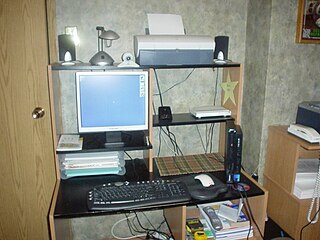 W
WLinux for PlayStation 2 is a kit released by Sony Computer Entertainment in 2002 that allows the PlayStation 2 console to be used as a personal computer. It included a Linux-based operating system, a USB keyboard and mouse, a VGA adapter, a PS2 network adapter, and a 40 GB hard disk drive (HDD). An 8 MB memory card is required; it must be formatted during installation, erasing all data previously saved on it, though afterwards the remaining space may be used for savegames. It is strongly recommended that a user of Linux for PlayStation 2 have some basic knowledge of Linux before installing and using it, due to the command-line interface for installation.
 W
WThe Linux Router Project (LRP) is a now defunct networking-centric micro Linux distribution. The released versions of LRP were small enough to fit on a single 1.44MB floppy disk, and made building and maintaining routers, access servers, thin servers, thin clients, network appliances, and typically embedded systems next to trivial.
 W
WMandriva Linux is a discontinued Linux distribution developed by Mandriva S.A.
 W
WMeeGo is a discontinued Linux distribution hosted by the Linux Foundation, using source code from the operating systems Moblin and Maemo. Primarily targeted at mobile devices and information appliances in the consumer electronics market, MeeGo was designed to act as an operating system for hardware platforms such as netbooks, entry-level desktops, nettops, tablet computers, mobile computing and communications devices, in-vehicle infotainment devices, SmartTV / ConnectedTV, IPTV-boxes, smart phones, and other embedded systems.
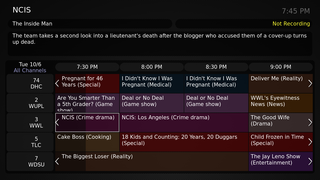 W
WMythbuntu is a discontinued media center operating system based on Ubuntu, which integrated the MythTV media center software as its main function, and did not install with all of the programs included with Ubuntu.
 W
WRed Flag Linux is a Linux distribution developed by Red Flag Software. The distribution logo is Tux carrying a prominent red flag. As of 2009, the executive president of Red Flag Software is Jia Dong (贾栋).
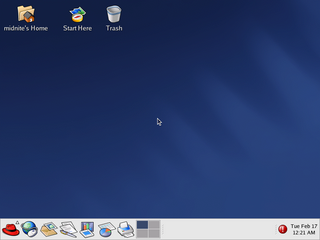 W
WRed Hat Linux; created by the company Red Hat, was a widely used Linux distribution until its discontinuation in 2004.
 W
WSoftlanding Linux System (SLS) was one of the first Linux distributions. It was founded by Peter MacDonald in May 1992. Their slogan at the time was "Gentle Touchdowns for DOS Bailouts".
 W
WTurbolinux was a Japanese Linux distribution targeting Asian users.
 W
WUbuntu GNOME is a discontinued Linux distribution, distributed as free and open-source software. It used a pure GNOME 3 desktop environment with GNOME Shell, rather than the Unity graphical shell. Starting with version 13.04 it became an official "flavour" of the Ubuntu operating system.
 W
WXbox Linux was a project that ported the Linux operating system to the Xbox video game console. Because the Xbox uses a digital signature system to prevent the public from running unsigned code, one must either use a modchip, or a softmod. Originally, modchips were the only option; however, it was later demonstrated that the TSOP chip on which the Xbox's BIOS is held may be reflashed. This way, one may flash on the "Cromwell" BIOS, which was developed legally by the Xbox Linux project. Catalyzed by a large cash prize for the first team to provide the possibility of booting Linux on an Xbox without the need of a hardware hack, numerous software-only hacks were also found. For example, a buffer overflow was found in the game 007: Agent Under Fire that allowed the booting of a Linux loader ("xbeboot") straight from a save game.
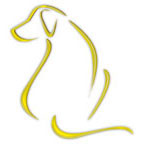 W
WYellow Dog Linux (YDL) is a discontinued free and open-source operating system for high-performance computing on multi-core processor computer architectures, focusing on GPU systems and computers using the POWER7 processor. The original developer was Terra Soft Solutions, which was acquired by Fixstars in October 2008. Yellow Dog Linux was first released in the spring of 1999 for Apple Macintosh PowerPC-based computers. The most recent version, Yellow Dog Linux 7, was released on August 6, 2012. Yellow Dog Linux lent its name to the popular YUM Linux software updater, derived from YDL's YUP and thus called Yellowdog Updater, Modified.